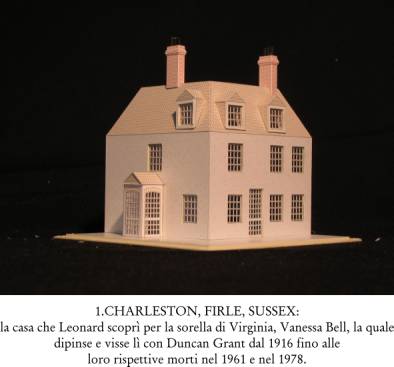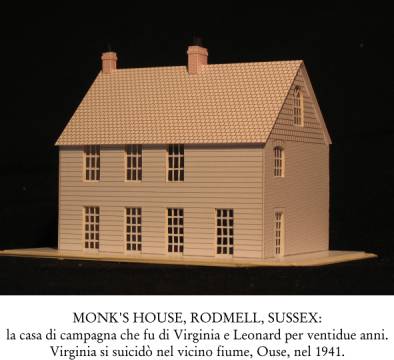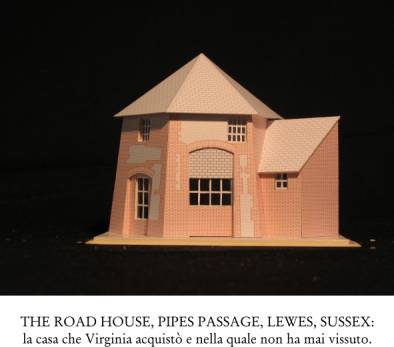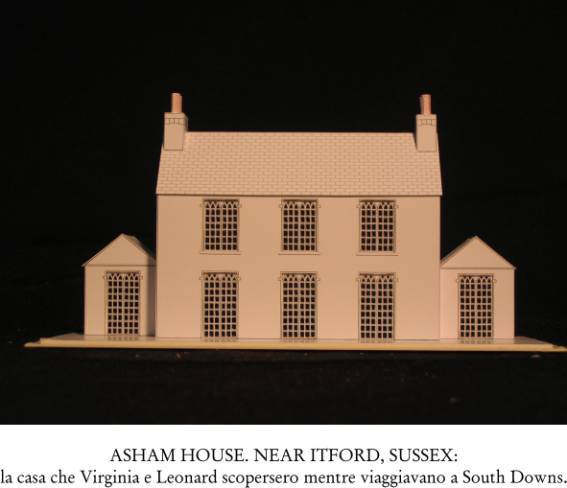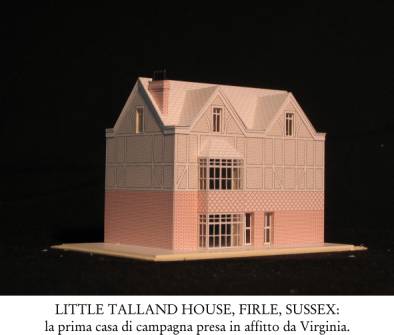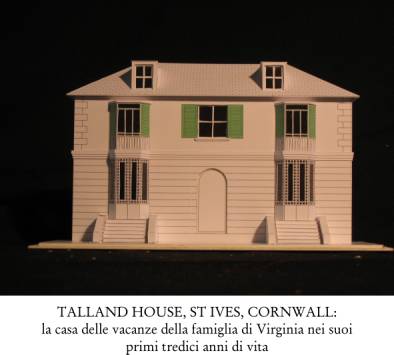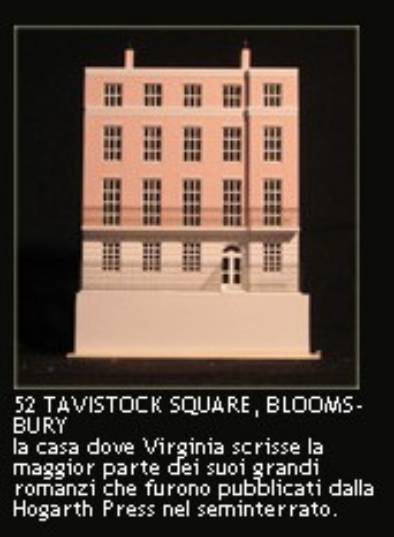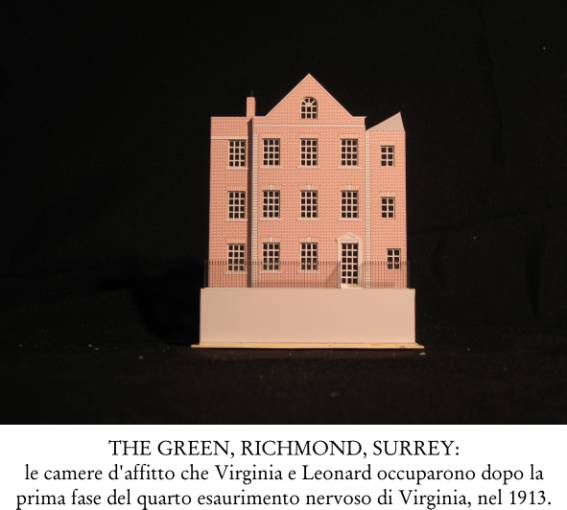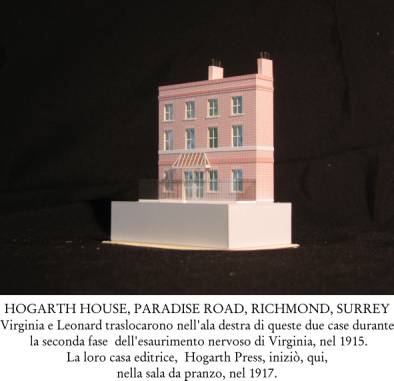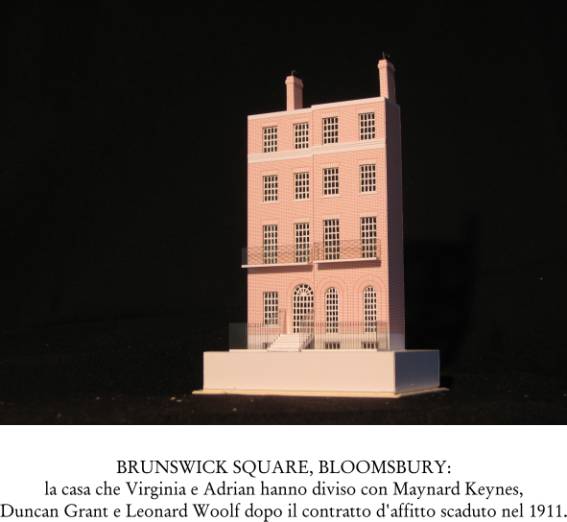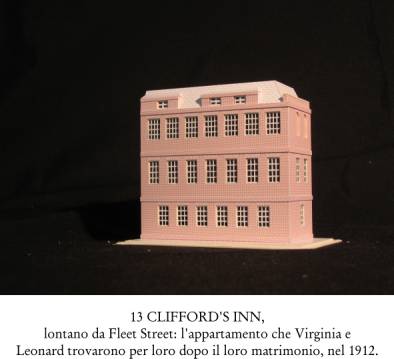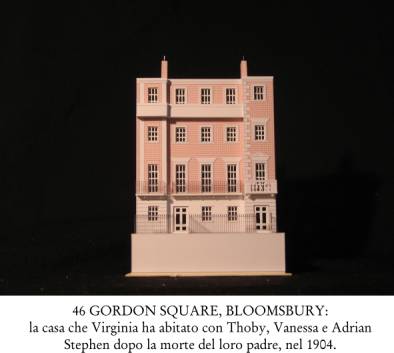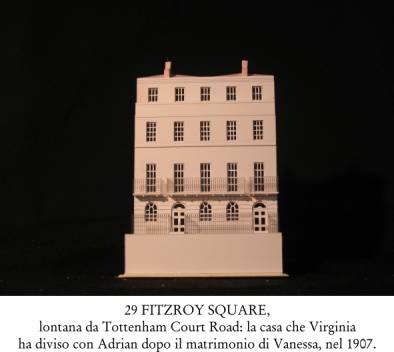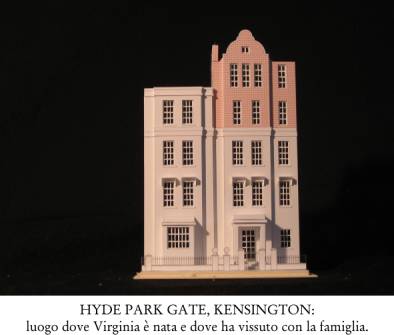
The houses of Virginia Woolf
by Giuseppe Bilotta
(translation by Mrs. Penny Ewles-Bergeron)
An
enthusiastic reader of Virginia Woolf, three months ago, in a Portalba bookshop,
I have the good fortune to find in my hands a book by Jean Moorcroft Wilson,
VIRGINIA WOOLF, Life and London, a biography of place, published in London in
1987 and never translated into Italian. The pale blue dust-jacket is illustrated
with a (young) profile of Virginia set against the façade of a London building.
Lower down, almost at the margin, the volume’s title ends with the note:
“with Illustrations, Maps and Guides”.
Immediately
I realise the importance of my acquisition. Full of excitement, I open it up and
realise that it is absolutely enjoyable to read. From the first to the last
page. With a simple and elegant style, the author sketches a twofold portrait of
the writer and the city of London. The prominence given to Virginia’s writing
and personality is equal to that provided by the beautiful drawings of all the
houses in which Virginia lived, drawings executed by Leonard McDermid, not
without considerable difficulty. He has brilliantly reproduced the houses that
have been demolished by studying old photographs of the period.
It
is superfluous to say that McDermid’s drawings are the most striking thing in
this very beguiling book: all realistically reproduced in black and white with a
dazzling sharpness of line. The caption of each indicates either the square or
the road in the district where each house stands, the period in which Virginia
occupied it and the most notable events and works connected with it. Their scale
and vividness, at which I gaze in admiration, set in motion my own imagination.
I
imagine how Virginia and Leonard would move around the rooms of the house in
their shared routines and in various states of mind during the course of a day.
The first image is that of Virginia and Leonard, newly married, entering the
apartment at Clifford’s Inn. Once inside, looking around and touching the
walls, perhaps they thought that buildings, symbols of something sheltering and
protecting, come to life for we humans and actually possess, as Alain de Botton
has written, their own moods and their own ideas? (Personally, since I was a
child, I felt that houses, in the protective sense of the Great Mother, speak to
us and convey a specific vision of happiness.)
Once
inside the “magical” Woolfian atmosphere, I remained there a long time
daydreaming about various moments of the writer’s existence and the vitality
of London that stimulated her imagination. First of all, however, I should say
that the idea suddenly occurred to me of devising an exhibition of these houses.
It was like a bolt of lightning. As if impelled by the Virginia’s spirit that
had established contact with my own. Was it empathy? Was it a reciprocal feeling
between author and reader? Why ask myself such questions? With Virginia, an
ethereal figure, everything is possible. It’s nothing to wonder at. It accords
with the “amorous consciousness” of foscolian memory. I do not even wonder
at the fact – I admit that it was such – that the one and only copy of the
book available should have been destined for me for a long time. It was there
where I found it.
Guiseppe
Manigrasso with his sculpture, Checco Moroso with his models and the Picagallery
all allowed me to turn this empathy into a concrete reality.
I
remind all Virginia’s readers that the editor of this book is Cecil Woolf,
Virginia’s nephew.
London
London.
Like a caput mundi? No. For Virginia it is quite simply “the centre of things”.
This does not mean that it is only a commercial or social centre, but the centre
of life itself. London has for her, as Moorcroft Wilson observes,[“a mystical
meaning; it is a symbol of that which variously she calls “life”,
“truth” or “reality”, a quality which she tries to find in her own life
and transfer into her work”]. London, in fact, offers her not only the
necessary starting point for writing her books, but also a subject for them. In
her diary she writes: [“London perpetually attracts, stimulates, inspires one
to write a play, a story, a poem without the least effort, only that of moving
my legs across the street”]. The city, where the life of millions of
inhabitants converges and palpitates day and night, inhabitants with their
stories and their routines, with their hopes and their worries, with their
appearance which is always new and surprising, in the streets and square, in the
public parks, in the boats which go up and down the Thames, in the Underground,
in the red double-decker buses, is for Virginia an inexhaustible source of
amazement. [“London is a dream”] she writes in another page of the diary.
And in yet another: [“I got out and step onto a tawny yellow magic carpet and
I find myself whisked away, into the wonder, without even lifting a finger.
Nights are astonishing, with all those white porticoes and the vast silent sky.
And the people who pop in and out, lightly, pleasantly, like rabbits”].
How could one resist such a spectacle? It is wonderful and relaxing to walk
about to observe and recollect it. Perhaps to transcribe into the diary the
feelings it summons up in her. Because she walks not only to observe, but also
to think, to devise new narrative outlines, to [“break apart”] the plot.
Here she is walking along Southampton Row, passing through patches of sunlight
on the pavements, [“declaiming phrases and envisioning scenes”]. With a
broad-brimmed straw hat on her head that shades her face right down to her mouth,
she wears a beige jacket over a spotted shirt and a tweed skirt. She moves
forward with a striking manner something between fierce and drifting. As she
passes people stop and turn to look at her. What world is she from? Leonard in
his autobiography writes that the amazement she inspires in others derives from
something ethereal and inaccessible emanating from her face and distinguishing
her from other people. [“I walk composing phrases”] she writes mingling with
the crowds in Oxford Street or in Cheyne Walk, in front of Carlyle’s house,
where is it [“eternally February”].
To her friend Vita Sackville-West she describes her London walks as “reviving
fires”. A fine image that captures how urban space, with its colours and
sounds, can excite her and revive at each step her passion for London.
If on the one hand London stimulates her imagination, on the other, nonetheless,
it risks exhausting her. It can stretch her nerves to the limit. The frantic
rhythm of the great metropolis can be damaging. From the moment her health
begins to oscillate between “sanity and insanity”, an excessive stimulus can
bring about a new collapse. Thus although she longs, as a narrator and flaneuse,
[“for certain alleyways and little courtyards between Chancery Lane and the
City”], she also needs to leave London to finish another work in progress and
to be ready to sustain the enormous creative effort this requires. She goes to
the country. The refuge ready to welcome her, with the green surroundings of its
garden, is Monk’s House, at Rodmell in Sussex. Here Virginia may work in peace.
The (temporary) abandonment of a London house for a country house, a frequent
occurrence throughout Virginia’s life, is punctuated by the normal exigencies
of existence. Which, besides editorial work, is devoted to visits to friends and
relatives, attendance at receptions, theatre and concert performances, journeys
to lectures either in London, country locations or other English cities.
In such transfers the houses in London or the houses outside London, in the
context of the ‘relationship of man to universe’, constitute a living and
reviving space, a real breathing architecture, in harmony with nature’s life
forces and geometry. For this reason, beside representing a point of arrival or
departure, their importance lies in what they signified for Virginia and for us,
we who see them (from the outside) and know how much time she lived within their
walls and which works were written there. We cannot visit them, for obvious
reasons, but it is still exhilarating to step back in time, to walk through a
patch of London while Big Ben strikes the quarter hour, as in the novels Mrs
Dalloway or The Years, to mark the effects of time, to stop in front of
Brunswick Square, Bloomsbury, where Virginia began the first novel The Voyage
Out, and imagine we see her come out with Rupert Brooke, the young poet who died
in the war in 1915. Or in her drawing room while she entertained her other great
friend, Lytton Strachey, who [“came today for tea and was very kind, putting
up with all my criticisms of life in Cambridge and of the …ums”]: (a
reference to the group of Apostles, the Bloomsbury intellectuals amongst whom
Thoby, Adrian, Virginia and Vanessa were the main members). Many books have been
written on The Bloomsbury Group, who were destined for more than three decades
to dominate the English cultural scene, not just that of London. Amongst their
authors Quentin Bell also figured, a nephew of Virginia and also her biographer.
Virginia loved London very much. Perhaps she hoped to finish her days there. It
was not to be. Remembering this, one’s thoughts turn to Monk’s House at
Rodmell, where Virginia has just risen to live the last day of her life. She
will not live the whole day. Towards midday it will have ended. Remembering her
final hours and the things she did seems to me an appropriate way to bring the
London chapter to a close.
Here I am in front of Monk’s House at Rodmell. It is a clear cold March day in
1941. Virginia comes out, walks across the garden, pushes the wooden gate -
behind which an elderly Leonard, as in a photograph, leans and watches – and
she leaves for her usual walk. The last. On the table in the study, with its
view onto the garden, she has left two letters, one for Leonard and one for
Vanessa, the people she loves the most, in which she explains that she still
hears the “voices” which oppress her. Taking her walking stick with her she
heads towards the Ouse. On the riverbank she inserts a large stone into her
jacket pocket and goes to meet death: [“the only experience that I will never
describe”].
Models
by Checco Moroso
The
search for ideal beauty, a sense of form and therefore a sense of “proportion”,
are especially active and cultivated in Checco: they facilitate both his pursuit
of ideals and the realisation of projects.
This
probably explains why the models of Virginia’s houses that he has created so
splendidly have an additional quality – the power to move. Instantly. Above
all to move artists, poets and sensitive souls. The models come from the heart
and aim at the heart. Like the greatest of thoughts. It is not too much to say
that the artistry which fashioned them out of simple cardboard beautifully
coloured with rose and beige is due to a particular state of grace in which
Checco worked after he’d been both dazzled and excited by the idea of the
project. Armed with photos of Leonard McDermid’s drawings, he set to work
straight away, between July and August shaping his creations at an exhilarating
pace of work that never slackened. So here they are, in front of me, only just
completed. I look at them carefully. They are so convincing that it seems as if
Checco has produced them from his own imagination and taste without recourse to
sketches or other preparatory studies. Doubtless he kept McDermid’s drawings
close at hand for guidance as to form, but the execution of each model is down
to his own merit.
It
is clear that all the models proceed from the classical tradition (by which I
mean the important lessons of the great works of the past), arriving, without
polemical detour, at a personal synthesis of interpretation. The balance they
demonstrate between material and tone is complete. It inspires emotion. It
leaves in the eye and heart the mark of perfection. The architectural elements
vary according to order and style. Such variety does not create confusion. Quite
the opposite. It is a positive thing. In the sense that it provides a
demonstration of the creative power of comparison in the modelling of the entire
series. It beguiles the sophisticated observer at first sight and probably the
less demanding observer too. Objects possessed of beauty are infallible: nobody
can escape their siren call – the “coup de foudre” which often proceeds
from the interrelationship of elements of the whole.
Checco
is well aware of this as he adjusts the aesthetics of each model. Precisely.
Without exception. Always with the same intensity and with a sure hand. Thus he
succeeds in making each model charming whether in a group or standing alone. The
remarkable subtlety of one is equal to the remarkable subtlety of the others: it
is as if a current of energy were passing from one model to another. One’s
gaze, nevertheless, continues to roam from one to another admiring the
felicitous craftsmanship of this or that detail.
If the house in Brunswick Square, Bloomsbury, with two turrets on the roof which
look like two little watchtowers, wins one over with its eaves, its architraves,
its windows, its stanchioned balconies, its doorway with round arch and steps
and lower windows protected by a wonderfully straight and symmetrical set of
railings, the three-storey house in Clifford’s Inn with its large hinged
windows, has all the air of a convoy that has halted mysteriously in this place
to offer itself to the eye of the viewer.
Of
the house in Gordon Square, Bloomsbury, which reminds one of a prim governess
presenting herself when called upon by the ‘Sir’ who employs her, what
strikes the viewer immediately is the balcony with parapet, balustrade, brackets,
placed on the left side of the well executed façade, just as well executed as
the three central balconies with railings. And what can one say of Hogarth
house? As splendid as Lady Ottoline Morrell, “who worships the arts” and is
a little left out of things, not taking part in a lively discussion between the
members of the Bloomsbury group; at Virginia’s house in Tavistock Square I am
gripped by the perfectly linear nature of the eaves, the entrance with its
double doors, the door posts and the iron railings. Monk’s House, at Rodmell,
with its cambered roof and the clustered turrets that speak one to the other,
pleases by its structural simplicity; a typical comfortable country house, safe
and calm, a house in which to pass work and leisure time in tranquillity. The
Round House, on the other hand, which seems designed to be inhabited by a fairy,
is really and truly a storybook house: tiny, pretty, with a hexagonal top and
something oriental about its outlines and its sloping roof. The external walls
are decorated with geometric elements vaguely Inca in character, while the
doorway and side windows are both designed with half arches.
For
the most part the architecture is Victorian. During the long reign of Queen
Victoria London’s urban areas witnessed enormous growth. New residential areas
sprang up. Numerous buildings were constructed throughout the urban area during
this remarkable expansion. The British Empire, which continued to flourish in
the second half of the nineteenth century, celebrated the last splendours of its
colonial power by making London greater and more beautiful.
The
houses where Virginia lived feel the effects of this Victorian atmosphere; but
their reconstruction in miniature, so to speak, resonates even more with the
pure “edifying” sentiment which Checco has impressed upon them whether with
his heart or with head. It is undeniable.
Checco’s
models remind one that habitat is the mirror and the extension not only of
Virginia’s existence, but also of our own existence anywhere in the world. In
this way they allow us to rediscover the correct relationship between our own
interior model and the surrounding environment. It’s like this. The high
definition plasticity displayed by Checco contributes to this discovery.
Insuperably. Behind which, obviously, one sees the euclidian study of form
brought gradually to perfection through time with the additional framework of
mathematics and neo-renaissance perspective. Such qualities, in the panorama of
modern architecture, assure an outstanding place for Checco’s mode of
discourse. Recognising the value of it means that by immortalising in
architecture our relationship with the cosmos, we take part in a greater work.
Virginia Woolf and Vita Sackville-West
Virginia
and Vita meet at a dinner at Clive Bell’s home. It is the 14th December 1922.
The meeting has been arranged by Clive who, quick to see Vita’s merits, tells
Virginia that Mrs Nicolson admires her work. When Virginia has before her “the
lovely gifted aristocratic Sackville-West”, her first impression of her is
both shrewd and wise. In her diary she writes that she finds her “not much to
my severer taste – florid, moustached, parakeet-coloured, with all the supple
ease of the aristocracy, but not the wit of the artist.” Words right on the
mark: a judgement that fits like a glove. Exactly. Having clarified this, she
adds: “But could I know her?” A momentary misgiving that doesn’t exclude
the possibility of getting to know her. It is as if she is playing for time -
more to reflect on the novelty of the encounter itself than to better understand
with whom she has to do: Virginia has “seen” and understood the whole of
Vita with her x-ray vision from the very first moment.
Vita, on the other hand, is enchanted with Virginia. Four days later she invites
her to dine at Ebury Street with Clive and Desmond MacCarthy. The day after that
she writes to Virginia’s husband Harold (on a diplomatic mission in Lausanne):
“I simply adore Virginia Woolf, and so would you. You would fall quite flat
before her charm and personality. [She] is so simple: she does give the
impression of something big. She is utterly unaffected: there are no outward
ornaments – she dresses quite atrociously. At first you think she is plain;
but then a sort of spiritual beauty imposes itself on you, and you find a
fascination in watching her. She is both detached and human, silent till she
wants to say something, and then says it supremely well”. Following this
attempt to sketch a portrait psychologique, from which it is clear that the
writer wishes to study Virginia and explore her greatness, she confesses that:
“I’ve rarely taken such a fancy to anyone, and I think she likes me. At
least, she’s asked me to Richmond where she lives. Darling, I have quite lost
my heart.” The “study” of Virginia ends with an admission that she is in
love – an understanding that includes both a perception (accurate) of not
displeasing Virginia and the satisfaction of having been invited to meet her
again.
When they meet Virginia is forty and Vita thirty. Vita is already well known as
a poetess and writer. Virginia tells us that “she has finished another book -
publishes with Heinemann’s - knows everyone”. A successful author and a
fascinating woman. Quentin Bell asserts that she is a beautiful woman, “in a
lazy, majestic, rather melancholy way”. Dark eyes and a certain grace of
bearing revealed in her “an exotic strain, the blood of disreputable Spanish
gypsies”.
I do not agree with Quentin Bell. For me she is not pretty, even less is she
beautiful, judging by the photographs I’ve seen which depict her both as a
young and as a mature woman. Her face has decidedly male features. With her
short haircut and the masculine clothes she wears she is a man. Nobody is fooled.
The manner in which she sits, crosses her legs, stands and looks is virile. Her
physical presence is devoid of all traces of feminine gracefulness. Seated in
profile at her desk in her writing-room at Sissinghurst, in indoor garb, in full
maturity, it is a man who turns her gaze towards Gisele Freund as she
photographs her. Her bold and bored expression is that of a man, as are her
broad wrists and swollen ankles. Not even her hair which falls a little over her
forehead and her left cheek is enough to give her the appearance of a woman. I
see a man projecting a dull and lacklustre image. A portrait of a country
nobleman who just about deigns to listen to what a servant is telling him from
the other end of the room. Where is the much-admired allure? I do not see it.
Perhaps it was imagined or concocted by friends and admirers in the salons of
London high society?
The impression of “virility” is strikingly evident in another photograph of
her taken at the foot of the tower of her house. Dressed like an Amazon, with a
German Shepherd dog crouched by her side, her long face is even more square and
heavy-featured like a man’s; she looks like a baron who waits at the threshold
to welcome a visitor, ready to produce a suitable smile and then maintain a
frozen patrician hauteur while he guides him through an inspection of the three
hundred and sixty five rooms of Knole, drowning in silence and shadows.
Even in a photo of an Orlando 1840-style, an Orlando of many lives and many
selves, the seated Vita, with her broad-brimmed hat across her forehead, with
her bushy eyebrows and the open fingers of her left hand between her chin and
cheek, in the classical melancholic pose, is a young man which his eyes fixed on
a distant point in space. Only the flowery blouse she wears over her kilt gives
her any feminine aspect. But still her facial features, the anxious, disturbed,
estranged look in her eyes are decidedly masculine: like those of a young
businessman, dressed as a woman, ready to take part in a fancy-dress ball in
some remote country house.
Virginia too remarks on Vita’s maleness: “she is a grenadier, hard,
beautiful, virile…”. She also notes that she “displays, with apparent
unconcern, a brown down on her cheek”. However she has “a pair of
magnificent legs” and she adds: “I like her and being with her and the
splendour.” She also likes the fact that she “stalks on legs like beech
trees”. To her eyes she seems “pink glowing, grape clustered, pearl hung”.
Limpid poetic images. Almost the Song of Songs. Unequivocably. Spontaneous
outbursts of emotion oscillating between eroticism and aestheticism. To put it
more simply, the overflowings of a dawning physical attraction. It’s all here.
It’s self-evident. It counts for little that in such a state of transport
itself lies hidden “the secret of her fascination”. Without taking anything
away from everything that attracted her about Vita, it would seem all the same
that it was her legs that appealed most of all. At any rate, Vita is seen as
“a real woman”, in whom there is “some voluptuousness”. For whom she
cannot restrain herself from admitting “I like her presence and her beauty”
and then asking herself “Am I in love with her?” This first question is
followed by a second: “But what is love?” to which she does not know how to
give a satisfactory reply. Then she moves onto other thoughts and observes:
“Her being ‘in love’ […] with me, excites and flatters and interests.”
Without doubt a need for “maternal protection”, such as she already gets
from Leonard and Vanessa, enters into that interest. Having decided that she can
rely on such a feeling, she is ready to succumb to Vita’s love.
For Virginia, as has happened for millennia, love arises from the sight of
beauty. At the start everything is in the eye: the vis-à-vis between the two
writers constitutes the overture. Despite their reciprocal reserve, the two like
each other and seek each other out in order to pursue their mutual observations.
Their courtship begins with supper invitations with their respective husbands,
an exchange of books and reciprocal compliments. Their marriages are similar in
the freedom they accord to each person’s private life: Harold cultivates
homosexual affairs and Leonard has written off the sexual side of his
relationship with Virginia having discovered her frigidity.
Two years pass from first meeting to physical contact. Sexual relations can be
dated exactly: 17th December 1925 during Virginia’s visit to Long Barn. Of
this same event, on 21st December upon her return, Virginia writes in her diary:
“Vita for three days at Long Barn, from which L. and I returned yesterday.
These Sapphists love women; friendship is never untinged with amorosity”. From
the proposition that follows the first note it seems that Virginia has forgotten
her own “sapphism” which she has expressed carnally with Vita and is amazed
that lesbians’ friendship is “never untinged with amorosity”. Soon
afterwards, as if brought brusquely back to the reality of the consummated
sexual act, she gets a grip on herself and justifies herself by saying: “In
short, my fears and refrainings, my ‘impertinence’, my usual
self-consciousness in intercourse with people who mayn’t want me and so on –
were all, as L. said, sheer fudge; and partly thanks to him (he made me write) I
wound up this wounded and stricken year in great style”.
The ending “in style” of this note is, perhaps, an allusion to the beginning
of her relationship with Vita? Probably. It is uncertain. What is certain,
however, is the period of their love affair that lasts from 1925 to 1929. Their
journey to France is also a fact. They set out from Monk’s House on 24th
September 1928. Paris. Once in the French capital it is easy to imagine that
after a quick trip to the Eiffel Tower they stroll to Place de la Concorde and
from there straight to the Louvre, Room L, to admire the famous Venus de Milo,
to take luncheon at La Vigne, a bistrot dating from 1900. Follies at the Lido,
with an international supper-show and a walk along the Seine amongst the
bouquinistes - print and second-hand booksellers.
A pleasant holiday that happens to coincide with the Radclyffe Hall affair which
explodes, as Quentin Bell narrates, “six days before the publication of
Orlando and five days after Virginia had, in another manner, identified herself
with the cause of homosexuality”. Radclyffe Hall writes the novel, The Well of
Loneliness, which causes a sensation when it first appears. It is the story of a
lesbian love which now would not scandalise a soul, but which at that time in
1928 was confiscated by the police. The author was brought to court.
On the subject of which, Virginia writes in her diary that one evening she and
Morgan, who was a weekend guest at Monk’s House, got very drunk and talked
about sodomy and lesbianism. She adds that the discussion “was started by
Radclyffe Hall and her meritorious dull book”.
On her return to England, Virginia realises that those days spent in Paris in
intimacy with Vita have enriched her both personally and artistically. The
friendship has positive effects. Reinvigorated, she writes to Harold describing
as “perfect” her week with her friend and she continues “Vita was an angel
to me – looked out trains, paid tips, spoke perfect French, indulged me in
every humour, was perpetually sweet tempered, endlessly entertaining, looked
lovely”. Words which show all the warmth and satisfaction experienced by
Virginia due to Vita’s affectionate and protective manner. Undoubtedly Vita
fascinated her by her maturity, her self-assurance, her education. Elegant,
nonchalant, de belle maniere, with the international jet set style glamour of
the age. A baroness raised in Kent at Knole, one of the greatest noble houses of
England, Vita, observes Jean Dunn, “incarnated in Virginia’s eyes centuries
of English history that had made her so negligently privileged and which
surrounded her with the fascination of the past”.
Vita, on her side, as Quentin Bell also affirms, is very much in love with
Virginia. On the word “love” I would be guarded. I have the sensation,
indeed, that the ardent temperament of Vita drives her in a male way to desire
Virginia: toward physical satisfaction in bed. It is not difficult to imagine
her seduction of Virginia. Vita’s conspicuous sexuality begets ardour, being
more orientated towards the male sex than the feminine. One might say that
having worked through a phase of feminine sensuality, a male sensuality takes
over in this bisexual female conquistador who gave birth to two sons.
Much has been said on the question of sexuality, beginning with Freud’s essays
and endless publications on the subject. The prolific volume of scientific
enquiry is commendable. What has been said, however, on this matter by Karl
Kraus, who is not a sexologist by profession but merely a great writer and
polemicist, seems to me to apply to Vita. Kraus, the defender of prostitutes and
homosexuals, maintains that woman is a being who is completely sexual: whatever
thing she desires or does derives from her essential sexuality. Seen from this
perspective woman is the opposite of man. Man has sexual needs whereas woman is
sexuality. As such she experiences feeling, but is irrational. Because she’s
irrational, she cannot control her own sexual nature. Man, on the other hand, as
a rational being, can. At least potentially. Sexuality exists along a spectrum.
I do not know whether Vita reached the uncontrollable extremes of Messalina’s
sexuality. Juvenal, in powerful stanzas, describes the Roman empress on the
prowl at night seeking satisfaction in the brothels of Rome.
Such a relationship, anyway, transferred to the ideal plane of femininity and
masculinity, results in the same thing. The androgynous nature of both women,
expressed to a greater degree in one and a lesser in the other, combine
harmoniously as described by Aristophenes in Plato’s Symposium. In this
respect one can understand what impulses determine Vita’s sexuality that
represents her real nature. Virginia, who is less sensual than Vita but much
more profoundly intellectual, understands all this and adapts herself to it.
Also because the masculinity of her friend perfectly balances her own.
Such a relationship thrills Vita. Her erotic euphoria is at its peak. In the
letters she writes to Clive Bell she always speaks in admiring terms of
Virginia. For her Virginia is “more entrancing than ever” and for she who is
“incredibly lovely and fragile”, she would “go to the ends of the earth”.
Such expressions seem, nonetheless, dictated more by physical passion than pure
love, a passion that lasts only as long as its flame lasts. When the fire is
extinguished, another lover will rekindle it: as happens most regularly with
Vita.
Such was the case with Virginia. Their erotic bond becomes a friendship lasting
till Virginia’s death. Skilful in conquest as she is, Vita has no difficulty
in addressing herself to other loves. It is enough to cast one’s eyes around:
a new lover is always in sight. The high society in which she moved offered
ample choice.
Seeing her with a new lover in tow, Vanessa writes to Virginia: “I hadn’t
seen Vita for ages. She had quite simply become Orlando, but in reverse: I mean
to say that she had become a man with thick whiskers and a very authoritarian
air and, in the mix, surely something much more”. Vanessa’s observations
tally with my own: within the seductive and impressive figure of Vita hides a
man, a man called Orlando (and who never transforms back into a woman as happens
in the novel).
Virginia, however, fascinated by Vita and by their love story writes Orlando:
“a biography beginning in the year 1500 and continuing to the present day”
to celebrate the existence and the personality of her friend. The book spans
three and a half centuries and presents Vita at the beginning in boy’s apparel
only to transform her into a woman later on. Written also with bravado, bolding
letting the whole world know about her attachment to Vita. Dedicated to her, the
romance is illustrated with photographs of Vita in the attire, whether male or
female, of Orlando and bears witness both to Virginia’s love for Vita and the
incidents of her own daily life during those years. The book, for which she
“shoves everything else aside”, grows by a chapter each time Virginia
descends on Knole to see Vita and extract confessions from her about her past.
Encouraged, Vita opens up: she speaks of her romantic entanglements with
Geoffrey Scott and Violet Trefussis who in the book appears as Sasha, the
Russian princess. She provides her with all the interesting details that
Virginia needs as she drafts the work. Vita is always ready to confess and
Virginia always “closed” so as not to reveal how the work is going.
It is better not to anticipate. To get to work. Focussed in the silence of her
own writing room. The surprise will be the greater when the first copy (printed)
arrives at Knole by post from the Hogarth Press followed closely behind by
Virginia with the manuscript, her gift.

